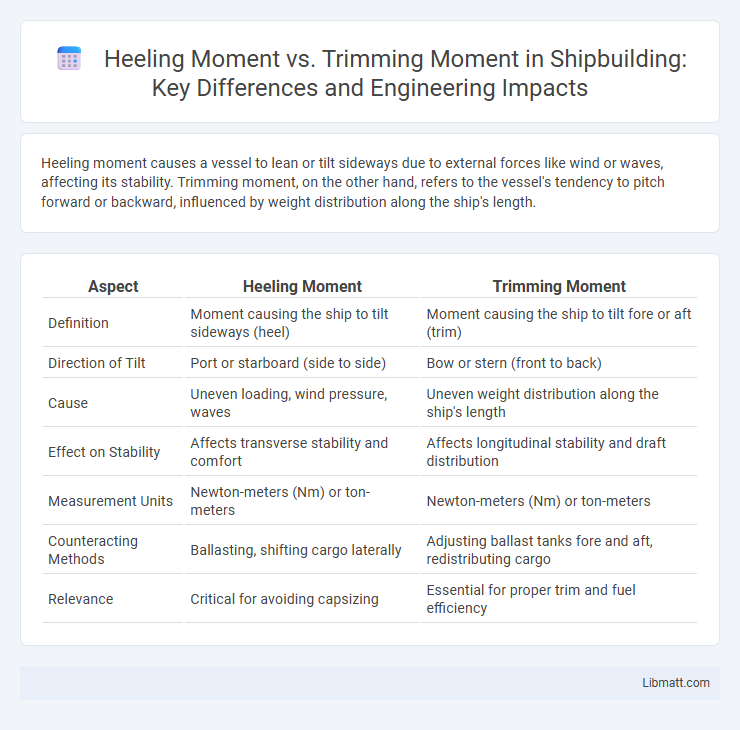Heeling moment causes a vessel to lean or tilt sideways due to external forces like wind or waves, affecting its stability. Trimming moment, on the other hand, refers to the vessel's tendency to pitch forward or backward, influenced by weight distribution along the ship's length.
Table of Comparison
| Aspect | Heeling Moment | Trimming Moment |
|---|---|---|
| Definition | Moment causing the ship to tilt sideways (heel) | Moment causing the ship to tilt fore or aft (trim) |
| Direction of Tilt | Port or starboard (side to side) | Bow or stern (front to back) |
| Cause | Uneven loading, wind pressure, waves | Uneven weight distribution along the ship's length |
| Effect on Stability | Affects transverse stability and comfort | Affects longitudinal stability and draft distribution |
| Measurement Units | Newton-meters (Nm) or ton-meters | Newton-meters (Nm) or ton-meters |
| Counteracting Methods | Ballasting, shifting cargo laterally | Adjusting ballast tanks fore and aft, redistributing cargo |
| Relevance | Critical for avoiding capsizing | Essential for proper trim and fuel efficiency |
Introduction to Heeling Moment and Trimming Moment
Heeling moment refers to the rotational force exerted on a vessel causing it to tilt sideways, primarily influenced by wind, waves, and shifting cargo. Trimming moment, on the other hand, involves the rotational force around the transverse axis, affecting the vessel's longitudinal balance and causing the ship to trim either by the bow or stern. Understanding the distinction between heeling and trimming moments is crucial for maintaining stability and ensuring safe navigation in maritime operations.
Definitions: Heeling Moment vs Trimming Moment
Heeling moment refers to the force causing a vessel to tilt sideways (heel) due to external factors like wind or waves, influencing stability and safety. Trimming moment describes the force that causes a ship to pitch forward or backward, altering its longitudinal trim and affecting performance and fuel efficiency. Understanding the distinction between heeling moment and trimming moment helps you manage vessel balance and ensure optimal navigation.
Causes of Heeling Moment in Ships
Heeling moment in ships arises primarily from external forces such as wind pressure on the superstructure, uneven loading of cargo or ballast, and waves striking the vessel's side, causing it to tilt. The distribution of weight and the ship's center of gravity play critical roles in the magnitude of the heeling moment. Unlike trimming moment, which affects the longitudinal pitch of the ship, heeling moment results in lateral inclination and impacts vessel stability.
Factors Influencing Trimming Moment
Trimming moment is primarily influenced by the distribution of weight and buoyancy along a vessel's length, affecting its longitudinal stability and trim angle. Key factors include cargo loading, fuel consumption, ballast water management, and hull form geometry, all altering the center of gravity and center of buoyancy. In contrast, heeling moment is mostly caused by lateral forces such as wind, waves, and turning motions, impacting the vessel's transverse stability.
Key Differences Between Heeling and Trimming Moments
Heeling moment refers to the rotational force causing a vessel to tilt sideways due to external forces like wind or waves, whereas trimming moment causes the vessel to pitch forward or backward along its longitudinal axis. The primary difference lies in their directional impact: heeling moment affects the ship's roll stability, while trimming moment influences its pitch and trim balance. Understanding these moments is crucial for maintaining vessel stability, safety, and optimal navigational performance.
Effects on Vessel Stability and Performance
Heeling moment, caused by external forces such as wind or waves, directly affects vessel stability by inducing a sideways tilt that can compromise safety and increase the risk of capsizing. Trimming moment, resulting from uneven weight distribution along the vessel's length, alters the ship's trim, impacting hydrodynamic performance by changing the hull's interaction with water and affecting fuel efficiency. Proper management of both moments is crucial to maintaining optimal stability, maneuverability, and overall vessel performance during maritime operations.
Calculation Methods for Heeling and Trimming Moments
Heeling moments are calculated by assessing the lateral forces such as wind or wave impacts acting on a vessel, often using formulas incorporating wind pressure, force arm, and the lever arm of the heeling force. Trimming moments involve evaluating longitudinal forces, including weight distribution and buoyancy shifts, typically calculated by multiplying the force causing trim by its distance from the vessel's center of flotation. Accurate determination of these moments is essential for ensuring Your ship's stability and optimal performance under various operational conditions.
Practical Examples in Marine Operations
Heeling moment and trimming moment are critical factors affecting vessel stability during marine operations such as cargo loading and ballast adjustments. Heeling moment, caused by uneven weight distribution or external forces like wind, affects the vessel's transverse inclination, while trimming moment impacts the longitudinal balance by altering the bow or stern draft. Understanding these moments is crucial for you to prevent capsizing risks and ensure safe navigation, especially in situations like passing heavy loads or managing fuel consumption.
Reducing Heeling and Trimming Moments: Best Practices
Reducing heeling and trimming moments is crucial for maintaining vessel stability and safety during navigation. Best practices include optimizing weight distribution by evenly loading cargo and ballast, adjusting sail trim to balance wind forces, and employing active stabilization systems such as anti-roll tanks or fin stabilizers. Regular monitoring of environmental factors like wave height and wind speed helps in making real-time adjustments to minimize excessive heeling and trimming moments.
Conclusion: Importance of Managing Vessel Moments
Effective management of vessel moments, including heeling and trimming moments, is critical for maintaining ship stability and safety. Heeling moments cause lateral inclination, affecting the vessel's balance and potentially leading to capsizing if unmanaged, while trimming moments influence the vessel's longitudinal trim, impacting fuel efficiency and maneuverability. Understanding and controlling these moments through proper load distribution and ballast adjustment ensures optimal performance and reduces risks during voyage operations.
Heeling moment vs trimming moment Infographic

 libmatt.com
libmatt.com